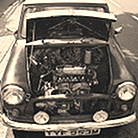|
Some folks just love to get under the hood, see what's going on in there. Others would just as soon not even know.

At Potlikker we don't demand or expect that you know or even care to know about all of this techno-mumbo-jumbo. But since it's our hobby, and since some clients have a real interest in the technical details, here is an attempt to catalog some of the many technologies we bring to bear to help you get what you want.
To the right is a brief run-down on the most common technologies we use. For more details, click the hyperlinked technologies and see the third column.
|
|
The following list includes some of the technologies that I've worked with:
- HTML - The basic markup language of the web.
- Cascading Style Sheets (CCS) - uses the 'stylesheet' concept with HTML
- JavaScript - the basic client-side scripting language that most websites use
- DHTML - a combination of client-side technologies that enable user-interactive display of page elements
- PHP - a free, well-supported server-side scripting language
- ASP - Microsoft's server-side scripting environment
- WordPress - Potlikker has set up and maintained several sites using the WordPress blogging engine, which is built using PHP
- Microsoft SharePoint 2007 (MOSS) and 2010 - more info coming soon
|
To get a glimpse of the HTML that renders this page, for example, you can do one of two things:
- right-click on your mouse any place on the page that isn't a link and scroll down the pop-up menu and click "View Source" (IE) or "View Page Source" (Netscape). A window will open showing all the client-side tags that work together to display the page.
- Or, go up to your browser's top menu and click "View" and then scroll down and click "Source" (IE) or "Page Source" (Netscape). The same window as mentioned above will open.
Not enough info?
Find out more!
|

